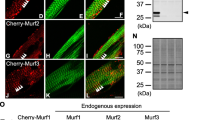Abstract
Phospholamban is a regulatory phosphoprotein which modulates the active transport of Ca2+ by the cardiac sarcoplasmic reticular Ca2+-ATPase enzyme (SERCA2) into the lumen of the sarcoplasmic reticulum. Phospholamban, which is a reversible inhibitor of SERCA2, represses the enzyme's activity, and this inhibition is relieved upon phosphorylation of phospholamban in response to β-adrenergic stimulation. In this way, phospholamban is an important regulator of SERCA2-mediated myocardial relaxation during diastole. This report centers on the hypothesis that the relative levels of phospholamban: SERCA2 in cardiac muscle plays an important role in the muscle's overall contractility status. This hypothesis was tested by comparing the contractile parameters of: a) murine atrial and ventricular muscles, which differentially express phospholamban, and b) murine wild-type and phospholamban knock-out hearts. These comparisons revealed that atrial muscles, which have a 4.2-fold lower phospholamban: SERCA2 ratio than ventricular muscles, exhibited rates of force development and relaxation of tension, which were three-fold faster that these parameters for ventricular muscles. Similar comparisons were made via analyses of left-ventricular pressure development recorded for isolated, work-performing hearts from wild-type and phospholamban knock-out mice. In these studies, hearts from phospholamban knock-out mice, which were devoid of phospholamban, exhibited enhanced parameters of left-ventricular contractility in comparison to wild-type hearts. These results suggest that the relative phospholamban: SERCA2 ratio is critical in the regulation of myocardial contractility and alterations in this ratio may contribute to the functional deterioration observed during heart failure.
Similar content being viewed by others
References
Lindeman JP, Jones LR, Hathaway DR, Henry BG, Watanabe AM (1983) β-adrenergic stimulation of phospholamban phosphorylation and Ca2+-ATPase activity in guinea pig ventricles. J Biol Chem 258: 464–471
Kranias EG (1985) Regulation of Ca2+ transport by cyclic 3′:5′-AMP-dependent and calcium-calmodulin dependent phosphorylation of cardiac sarcoplasmic reticulum. Biochim Biophys Acta 844: 193–199
Kranias EG (1986) Regulation of Ca2+ transport by phosphoprotein phosphatase activity associated with cardiac sarcoplasmic reticulum. J Biol Chem 260: 11006–11010
Edes I, Kranias EG (1989) Regulation of the cardiac sarcoplasmic reticulum function by phospholamban. Membr Biochem 7: 175–192
Mundina de Weilenmann C, Vittone L, de Cingolani G et al. (1987) Dissociation between contraction and relaxation: The possible role of phospholamban phosphorylation. Basic Res Cardiol 82: 507–516
Kranias EG, Garvey JL, Srivastava RD et al. (1985) Phosphorylation and functional modifications of sarcoplasmic reticulum and myofibrils in isolated rabbit hearts stimulated with isoprenaline. Biochem J 226: 113–121
Talosi L, Edes I, Kranias EG (1993) Intracellular mechanisms mediating the reversal of β-adrenergic stimulation in intact beating hearts. Am J Physiol 264: H791-H797
Luo W, Grupp IL, Doetschman T, Ponniah S, Harrer J, Zhou Z, Kranias EG (1994) Targeted ablation of the phospholamban gene is associated with markedly enhanced myocardial contractility and loss of β-agonist stimulation. Circ Res 75: 401–409
Luo W, Kiss E, Koss KL, Grupp IL, Harrer J, Edes I, Jones WK, Kranias EG (1995) Cardiac remodeling by alterations in phospholamban protein levels. Heart Hypertrophy and Failure. Dhalla NS, Pierce GN, Panagia V, Blamish RE (eds) Kluwer Academic Press, Boston, MA (in press)
Grupp IL, Kranias EG, Kiss E, Harrer JM, Slack J, Koss KL, Lui W, Grupp G (1995) The contribution of phospholamban, a sarcoplasmic reticulum phosphoprotein, to myocardial contractility in health and disease. Heart Failure 11: 48–61
Koss KL, Ponniah S, Jones WK, Grupp IL, Kranias EG (1995) Differential expression of the phospholamban gene in murine cardiac compartments: Molecular and physiological analyses. Circ Res 77: 342–353
Sambrook J, Fritsch EF, Maniatis T (1989) Molecular Cloning. New York, NY: Cold Spring Harbor Laboratory Press
Cox KH, DeLeon DV, Angerer LM, Angerer RC (1984) Detection of mRNAs in sea urchin embryos byin situ hybridization using asymmetric RNA probes. Dev Biol 101: 485–502
Jones WK, Sanchez A, Robbins JR (1994) The murine pulmonary myocardium: developmental analysis of cardiac gene expression. Dev Dyn 200: 117–128
Grupp IL, Grupp G (1984) Isolated heart preparations perfused or superfused with balanced salt solutions. Methods in Pharmacol 5: 111–128
Toyofuku T, Zak R (1991) Characterization of cDNA and genomic sequences encoding a chicken phospholamban J Biol Chem 266: 5375–5383
Kiss E, Jakab G, Kranias EG, Edes I (1994) Thyroid hormone-induced alterations in phospholamban protein expression: regulatory effects on sarcoplasmic reticulum Ca2+ transport and myocardial relaxation. Circ Res 75: 245–251
Garvey J, Kranias EG, Solaro RJ (1988) Phosphorylation of C-protein, troponin I, and phospholamban in isolated rabbit hearts. Biochem J 245: 709–714
Presti CF, Jones LR, Lindemann JP (1991) Isoproterenol-induced phosphorylation of a 15-kilodalton sarcolemmal protein sarcolemmal protein in intact myocardium. J Biol Chem 266: 11126–11130
Arai M, Otsu K, MacLennan DH, Alpert NR, Periasamy M (1991) Effect of thyroid hormone on the expression of mRNA encoding sarcoplasmic reticulum proteins. Circ Res 69: 266–276
Author information
Authors and Affiliations
Rights and permissions
About this article
Cite this article
Koss, K.L., Grupp, I.L. & Kranias, E.G. The relative phospholamban and SERCA2 ratio: a critical determinant of myocardial contractility. Basic Res Cardiol 92 (Suppl 1), 17–24 (1997). https://doi.org/10.1007/BF00794064
Issue Date:
DOI: https://doi.org/10.1007/BF00794064




